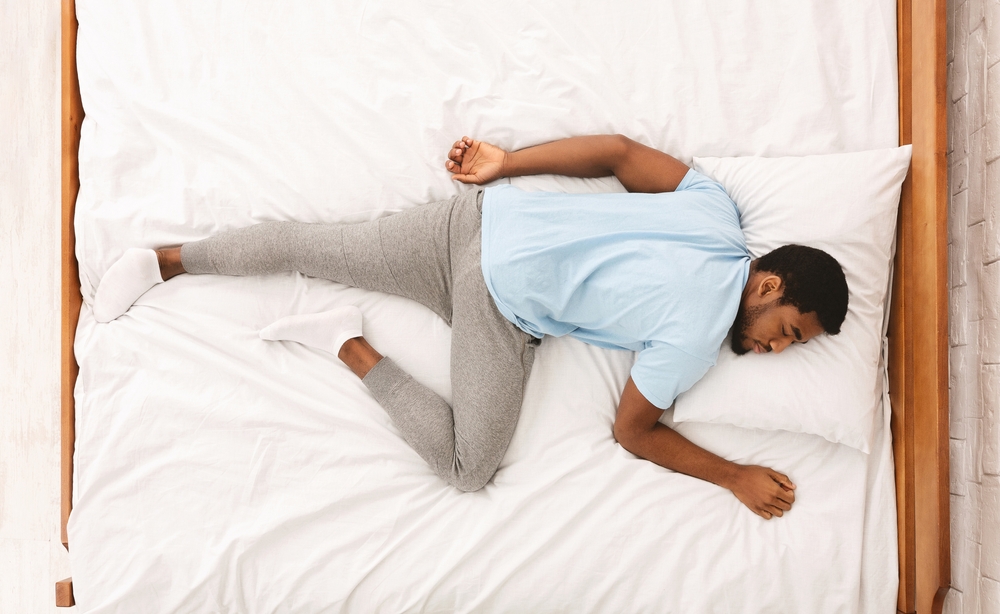You wake up every morning with that familiar ache in your lower back, and you’ve probably blamed your mattress, your age, or maybe that workout you did three days ago. But here’s what you might not realize: the way you sleep could be the real culprit behind your chronic back pain.
That cozy position you’ve been sleeping in for years might be slowly wreaking havoc on your spine, and you’d never suspect it because it feels so natural and comfortable when you drift off to sleep.
Stomach sleeping is the biggest offender
Let’s be real — stomach sleeping feels amazing when you first settle into bed. It’s like being wrapped in a warm hug, and many people find it easier to fall asleep this way. But this sleep position back pain connection is stronger than most people realize.
When you sleep on your stomach, your spine gets twisted into an unnatural position for hours at a time. Your lower back arches excessively, creating pressure on your joints and muscles. Meanwhile, your neck has to turn to one side so you can breathe, which strains your cervical spine and can lead to neck pain too.
Think about it — you’re essentially forcing your spine to maintain a curved, twisted position for six to eight hours straight. No wonder you wake up feeling like you’ve been hit by a truck.
Why stomach sleeping feels so good initially
The reason stomach sleeping feels comfortable at first is because it provides a sense of security and can help reduce snoring. Many people unconsciously choose this position because it feels protective and cozy. But what feels good in the moment can create long-term problems.
Your body adapts to this position over time, and your muscles work all night to maintain it. This constant muscle tension and spinal stress accumulates, leading to chronic pain that gets worse over time rather than better.
The pressure on your organs can also affect your breathing and digestion, though you might not connect these issues to your sleeping position.
The domino effect on your entire body
When your spine is misaligned during sleep, it doesn’t just affect your back. Poor spinal alignment can cause hip pain, shoulder tension, and even headaches. Your body is all connected, and when one part is out of whack, everything else compensates.
Many stomach sleepers develop tight hip flexors because this position keeps your hips in a flexed position all night. These tight muscles pull on your lower back, creating even more pain and stiffness when you try to stand up straight in the morning.
Your shoulders also suffer because you’re likely sleeping with your arms under your pillow or body, which can compress nerves and reduce circulation.
Side sleeping as the better alternative
If you’re a dedicated stomach sleeper, transitioning to side sleeping can dramatically reduce your back pain. Side sleeping keeps your spine in a more natural alignment and reduces pressure on your joints and muscles.
The key to healthy side sleeping is proper pillow placement. Put a pillow between your knees to keep your hips aligned, and make sure your head pillow supports your neck without tilting it too far up or down. Your ear, shoulder, and hip should form a straight line.
It might feel weird at first, especially if you’ve been a stomach sleeper for years, but give your body time to adjust. Most people start feeling better within a few weeks of switching positions.
Back sleeping for optimal spine health
Back sleeping is actually the best position for spine health, though many people find it uncomfortable initially. When you sleep on your back, your spine maintains its natural curves, and your weight is evenly distributed across your entire body.
Place a small pillow under your knees to reduce pressure on your lower back, and choose a head pillow that supports your neck’s natural curve without pushing your head too far forward. Your pillow should fill the space between your neck and the mattress.
This position also prevents wrinkles and reduces acid reflux, so there are bonus benefits beyond just back pain relief.
Making the transition easier
Changing your sleep position back pain habits takes patience and consistency. Start by falling asleep in your new position, even if you wake up having moved during the night. Gradually, your body will adapt to staying in the healthier position.
Use extra pillows to prop yourself into the correct position and prevent rolling. Body pillows can be especially helpful for side sleepers, while back sleepers might benefit from pillows on either side to prevent rolling over.
Consider your mattress quality too. A supportive mattress makes any sleeping position more comfortable and effective for pain prevention.
When to seek professional help
If you’ve tried changing your sleep position and still experience chronic back pain, it might be time to consult a healthcare professional. Sometimes underlying conditions or other factors contribute to pain that won’t resolve with position changes alone.
Physical therapy can help strengthen the muscles that support your spine and teach you exercises to counteract years of poor sleeping posture.
Bottom line? Your sleep position matters more than you think. If you’re waking up with back pain every morning, take a hard look at how you’re sleeping. That comfortable stomach position might be sabotaging your spine health one night at a time.

















